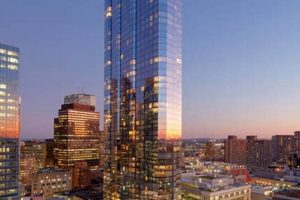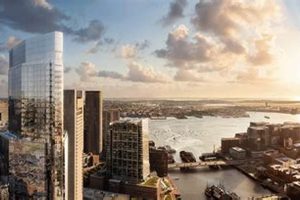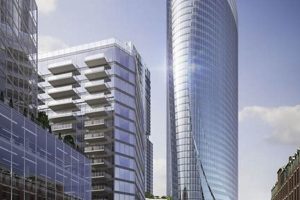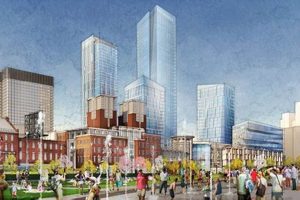The Turning Torso skyscraper is a neo-futurist residential skyscraper in the city of Malm, Sweden. It is the tallest building in Scandinavia and the tallest residential building in Europe. The building was designed by Spanish architect Santiago Calatrava and was completed in 2005. The Turning Torso is known for its unique design, which resembles a twisted torso. The building is made up of nine cubes, which are stacked on top of each other in a twisting motion. The Turning Torso is a popular tourist destination and has won numerous awards for its design.
The Turning Torso is an important landmark in Malm and is a symbol of the city’s modern architecture. The building has been featured in numerous films and television shows and has become a popular tourist destination. The Turning Torso is also a popular place to live, and its apartments are some of the most expensive in Malm.
The Turning Torso is a unique and iconic building that has become a symbol of Malm. The building is a testament to the city’s modern architecture and is a popular tourist destination.
1. Height
The Turning Torso skyscraper’s height of 190 meters (623 feet) is a defining characteristic that contributes to its architectural significance and visual impact. As one of the tallest buildings in Scandinavia, its height allows it to dominate the Malm skyline and become a recognizable landmark.
The building’s height is not merely a matter of aesthetics; it also serves several practical purposes. The increased elevation offers panoramic views from its upper floors, making the apartments highly desirable and providing residents with breathtaking vistas of the city and surrounding landscape. Additionally, the height enhances the building’s structural stability, ensuring its resilience against strong winds and seismic activity.
Furthermore, the Turning Torso’s height plays a crucial role in its unique design concept. The twisting motion of the building’s nine cubes is accentuated by its vertical extension, creating a dynamic and visually striking form. The interplay between height and form gives the skyscraper its iconic character and makes it a captivating sight for visitors and residents alike.
2. Floors
The Turning Torso skyscraper comprises 54 floors, each meticulously designed to complement the building’s overall form and functionality. This number of floors is not arbitrary but rather carefully considered to achieve several key objectives.
Firstly, the 54 floors allow for the creation of diverse and flexible living spaces within the skyscraper. The building accommodates a mix of residential apartments, ranging from smaller units to luxurious penthouses, catering to a wide range of tastes and lifestyles. The ample number of floors ensures that there is sufficient space to accommodate these varied apartment types while maintaining a comfortable living environment for residents.
Secondly, the 54 floors contribute to the building’s structural integrity and stability. The skyscraper’s unique twisting design necessitates careful engineering to withstand lateral forces such as wind and seismic activity. The multiple floors act as horizontal diaphragms, distributing these forces throughout the structure and preventing excessive swaying or deformation.
Thirdly, the 54 floors enhance the building’s overall aesthetics and visual impact. The stepped arrangement of the cubes, each representing a few floors, creates a dynamic and visually striking form that sets the Turning Torso apart from conventional skyscrapers. The interplay between the horizontal floors and the twisting motion gives the building a sense of movement and fluidity.
In conclusion, the 54 floors of the Turning Torso skyscraper are not merely a numerical value but a fundamental aspect of its design, functionality, and aesthetics. The careful consideration given to the number of floors has resulted in a building that is both practical and visually captivating.
3. Architect
The Turning Torso skyscraper in Malm, Sweden, is a striking example of the renowned architect Santiago Calatrava’s innovative and expressive design style. Calatrava’s unique approach to architecture is evident in the building’s distinctive form, which resembles a twisting human torso. This connection between the architect and his creation is significant for several reasons.
Firstly, Calatrava’s background in engineering and his fascination with human anatomy have greatly influenced the design of the Turning Torso. The building’s form is not merely an aesthetic choice but a reflection of Calatrava’s belief that architecture should be both functional and evocative of human movement and form. The twisting motion of the cubes represents the dynamic nature of the human body, creating a visually captivating and organic structure.
Secondly, Calatrava’s attention to detail and commitment to excellence are evident in every aspect of the Turning Torso. The building’s facade is composed of glass panels that reflect the changing colors of the sky, creating a dynamic and ever-evolving appearance. The interior spaces are designed to maximize natural light and offer stunning views of the surrounding city and waterfront. Calatrava’s passion for creating beautiful and functional spaces is evident throughout the building.
In conclusion, the connection between “Architect: Santiago Calatrava” and “turning torso skyscraper” is crucial in understanding the building’s unique design, its embodiment of Calatrava’s architectural philosophy, and its status as an iconic landmark in Malm.
4. Location
The Turning Torso skyscraper is inextricably linked to its location in Malm, Sweden. This connection is not merely geographical but extends to the building’s design, functionality, and cultural significance.
Firstly, the city of Malm played a pivotal role in shaping the skyscraper’s design. Malm’s rich maritime history and industrial heritage influenced architect Santiago Calatrava’s vision for the building. The Turning Torso’s twisting form is reminiscent of a ship’s hull, paying homage to the city’s shipbuilding past. Additionally, the building’s proximity to the water provides stunning views of the resund Strait and the neighboring city of Copenhagen, enhancing the residents’ living experience.
Secondly, the location of the Turning Torso within Malm has significant practical implications. The skyscraper is situated in the Western Harbour district, a vibrant and rapidly developing area. This strategic location provides residents
with easy access to a wide range of amenities, including shopping malls, restaurants, and cultural attractions. The building’s proximity to the city center and excellent public transportation links further enhance its desirability as a residential address.
Beyond its practical advantages, the Turning Torso’s location in Malm has imbued it with cultural significance. The skyscraper has become an iconic landmark, synonymous with the city’s modern and innovative image. It has been featured in numerous films, television shows, and publications, solidifying its status as a symbol of Malm’s architectural prowess.
In conclusion, the connection between “Location: Malm, Sweden” and “turning torso skyscraper” is multifaceted, encompassing the building’s design, functionality, and cultural significance. The skyscraper’s unique form, strategic location, and symbolic value have made it an integral part of Malm’s identity and a testament to the city’s architectural ambition.
5. Design
The design of the Turning Torso skyscraper is a harmonious blend of neo-futuristic aesthetics and organic forms, primarily characterized by its resemblance to a twisted human torso. This distinctive design approach has profound implications for the building’s overall appearance, functionality, and symbolic meaning.
- Biomorphic Form:
The twisted torso shape is a striking departure from conventional skyscraper designs. It mimics the dynamic and fluid forms found in nature, creating a visually captivating and iconic structure. The building’s nine interconnected cubes, arranged in a twisting motion, evoke the image of a human spine, adding a layer of organic elegance to its futuristic appearance. - Wind Resistance:
The twisted form of the Turning Torso is not merely an aesthetic choice but also a strategic design element. The varying angles of the cubes disrupt the wind flow, reducing the building’s overall wind resistance. This innovative design feature enhances the building’s structural stability and ensures its resilience against strong winds, a crucial consideration in its exposed waterfront location. - Panoramic Views:
The twisting motion of the cubes creates a series of staggered balconies, offering residents panoramic views of the surrounding cityscape, the resund Strait, and the neighboring city of Copenhagen. The varying orientations of the balconies ensure that each apartment has unique and breathtaking vistas, maximizing the building’s appeal as a luxury residential address. - Symbolic Identity:
The Turning Torso’s distinctive design has become synonymous with the city of Malm, embodying its modern and progressive image. The building’s resemblance to a twisted torso has been interpreted as a metaphor for the city’s own transformation from an industrial hub to a vibrant and cosmopolitan center. The Turning Torso has become an iconic landmark, attracting visitors from around the world and solidifying its status as a symbol of Malm’s architectural prowess.
In conclusion, the design of the Turning Torso skyscraper, characterized by its neo-futuristic aesthetics and twisted torso shape, is a masterful blend of form and function. The building’s biomorphic form, wind resistance, panoramic views, and symbolic identity have made it an architectural marvel and an iconic landmark in the city of Malm.
6. Construction
The use of reinforced concrete in the construction of the Turning Torso skyscraper is a crucial aspect that has significantly influenced the building’s structural integrity, aesthetic appeal, and overall design. Reinforced concrete is a composite material consisting of concrete reinforced with steel bars or fibers, providing exceptional strength and durability.
- Exceptional Strength and Durability:
Reinforced concrete is renowned for its high compressive strength, which is essential for skyscrapers that must withstand immense gravitational forces. The steel reinforcement within the concrete enhances its tensile strength, allowing the building to resist bending and deformation under various loads. This combination of strength and durability ensures the Turning Torso’s resilience against external forces such as high winds and seismic activity. - Design Flexibility:
Reinforced concrete offers remarkable design flexibility, enabling architects to create complex and innovative structures. In the case of the Turning Torso, the use of reinforced concrete allowed Santiago Calatrava to realize his vision of a twisting, organic form. The concrete’s moldability facilitated the creation of the building’s nine interconnected cubes, each rotated slightly from the one below, resulting in the iconic twisted torso shape. - Fire Resistance:
Reinforced concrete possesses excellent fire resistance properties. In the event of a fire, the concrete acts as a protective layer, shielding the steel reinforcement from excessive heat. This characteristic contributes to the Turning Torso’s overall safety and Bewohner the building’s occupants in case of a fire emergency. - Cost-Effectiveness:
Compared to other building materials, reinforced concrete is relatively cost-effective. Its durability and low maintenance requirements make it a practical choice for high-rise constructions. In the case of the Turning Torso, the use of reinforced concrete helped keep construction costs within budget, allowing for the realization of Calatrava’s ambitious design.
In conclusion, the use of reinforced concrete in the construction of the Turning Torso skyscraper played a pivotal role in shaping its structural integrity, design flexibility, fire resistance, and cost-effectiveness. This remarkable material enabled the creation of an iconic landmark that stands as a testament to the innovative and functional possibilities of reinforced concrete in modern architecture.
7. Awards
The Emporis Skyscraper Award is a prestigious annual award that recognizes outstanding achievements in high-rise architecture worldwide. The Turning Torso skyscraper was the recipient of this award in 2005, a testament to its exceptional design and innovative construction. This accolade has significantly contributed to the building’s global recognition and reputation as an architectural masterpiece.
- International Recognition:
The Emporis Skyscraper Award is widely regarded as one of the most prestigious awards in the field of high-rise architecture. The Turning Torso’s receipt of this award has brought it international recognition and acclaim, solidifying its status as a globally renowned architectural landmark. - Design Excellence:
The jury of the Emporis Skyscraper Award specifically commended the Turning Torso’s unique and innovative design. The building’s distinctive twisting form, inspired by a human torso, sets it apart from conventional skyscrapers and showcases the architect’s creativity and vision. - Engineering Prowess:
The award also recognized the engineering prowess behind the Turning Torso. The building’s complex design required innovative structural solutions to ensure
its stability and resilience against high winds and seismic activity. The award acknowledges the exceptional engineering skills that brought Calatrava’s vision to life. - Urban Impact:
The Emporis Skyscraper Award considers the impact of skyscrapers on their surrounding urban environment. The Turning Torso has become an iconic landmark in the city of Malm, enhancing its skyline and contributing to its overall identity. The award recognizes the building’s positive impact on the city’s image and livability.
In conclusion, the Turning Torso skyscraper’s receipt of the Emporis Skyscraper Award in 2005 is a testament to its architectural excellence, innovative design, engineering prowess, and positive urban impact. This prestigious award has solidified the building’s status as a globally recognized architectural masterpiece.
8. Landmark
The Turning Torso skyscraper has become an iconic landmark in the city of Malm, Sweden, symbolizing its modern and progressive architectural landscape.
The building’s unique and striking design, resembling a twisted human torso, has made it a globally recognized symbol of Malm’s architectural prowess. Its prominent location in the Western Harbour district further enhances its visibility and impact on the city’s skyline.
As a landmark, the Turning Torso has played a significant role in shaping Malm’s identity and promoting its image as a forward-looking and innovative city. Its presence has attracted tourists and visitors from around the world, contributing to Malm’s cultural and economic development.
Furthermore, the Turning Torso’s status as a landmark has had a positive impact on the surrounding urban environment. The building’s unique form and design have revitalized the Western Harbour district, attracting new businesses, residents, and cultural institutions to the area. It has stimulated urban renewal and regeneration, transforming the district into a vibrant and sought-after neighborhood.
In conclusion, the connection between the Turning Torso skyscraper and its status as a landmark of Malm’s modern architecture is mutually reinforcing. The building’s unique design and iconic status have made it a symbol of the city’s architectural ambition and have contributed to Malm’s reputation as a center of modern and innovative architecture.
9. Residential
The Turning Torso skyscraper is renowned for its luxurious residential apartments, which offer breathtaking panoramic views of the surrounding cityscape and waterfront. This unique feature is deeply intertwined with the building’s overall design and concept, contributing to its desirability and status as an exclusive residential address.
- Unobstructed Vistas:
The Turning Torso’s twisting form and staggered balconies ensure that each apartment enjoys unobstructed views in multiple directions. Residents can take in the panoramic beauty of Malm, the resund Strait, and the neighboring city of Copenhagen from the comfort of their own homes. - Natural Light and Ventilation:
The floor-to-ceiling windows that characterize the apartments allow for abundant natural light to flood in, creating a bright and airy living environment. The balconies provide ample opportunities for fresh air and ventilation, enhancing the overall comfort and well-being of the occupants. - Exclusive Amenities:
The residential component of the Turning Torso is complemented by a range of exclusive amenities that cater to the needs of discerning residents. These include a fully equipped fitness center, a rooftop terrace with panoramic views, and 24-hour concierge services. - Symbol of Luxury and Prestige:
The Turning Torso’s luxury apartments have become synonymous with exclusivity, prestige, and a sophisticated lifestyle. Residents enjoy the privilege of living in one of the most iconic buildings in Scandinavia, a symbol of architectural innovation and modern luxury.
In conclusion, the connection between “Residential: Luxury apartments with panoramic views” and “turning torso skyscraper” is multifaceted, encompassing the building’s unique design, exceptional amenities, and its status as a symbol of luxury and prestige. These factors combine to create a highly desirable and exclusive residential experience that sets the Turning Torso apart as an architectural marvel and a sought-after address in Malm.
Frequently Asked Questions about the Turning Torso Skyscraper
The Turning Torso skyscraper, with its unique design and innovative construction, has sparked considerable interest and curiosity. Here are answers to some of the most frequently asked questions about this architectural marvel:
Question 1: What inspired the unique twisting design of the Turning Torso?
The Turning Torso’s distinctive twisting form was inspired by the human torso, as envisioned by renowned architect Santiago Calatrava. The building’s design evokes a sense of movement and fluidity, resembling a twisting spine.
Question 2: How tall is the Turning Torso, and how many floors does it have?
The Turning Torso stands at an impressive 190 meters (623 feet) tall and comprises 54 floors. Its height and number of floors make it one of the tallest residential buildings in Europe.
Question 3: What materials were used in the construction of the Turning Torso?
The Turning Torso’s structural integrity is ensured by the use of reinforced concrete, known for its strength and durability. The building’s facade is adorned with glass panels, allowing for ample natural light and panoramic views.
Question 4: What is the significance of the Turning Torso’s location in Malm?
The Turning Torso’s location in Malm’s Western Harbour district is strategic, providing stunning views of the city and the resund Strait. It has become an iconic landmark, symbolizing Malm’s modern architecture and urban development.
Question 5: What types of units are available in the Turning Torso, and what amenities are offered?
The Turning Torso offers a range of luxurious apartments, from smaller units to penthouses, catering to diverse preferences. Residents have access to exclusive amenities, including a fitness center, rooftop terrace, and 24-hour concierge services.
Question 6: Has the Turning Torso received any notable awards or recognition?
In recognition of its architectural excellence, the Turning Torso was awarded the Emporis Skyscraper Award in 2005. This prestigious award highlights the building’s innovative design and its contribution to the field of high-rise architecture.
These frequently asked questions provide insights into the design, construction, significance, and amenities of the Turning Torso skyscraper. Its unique form, impressive height, innovative materials, strategic location, luxurious apartments, and award-winning status make it a remarkable architectural achievement and an iconic landmark in the city of Malm.
Tips for Understanding and Appreciating the Turning Torso Skyscraper
To fully grasp the architectural marvel of the Turning Torso skyscraper, consider these informative tips:
Tip 1: Study its Design Concept: Explore the building’s unique twisting form,
inspired by the human torso. Understand how this design mimics human movement and creates a sense of fluidity.
Tip 2: Observe its Height and Structure: Appreciate the building’s impressive height of 190 meters (623 feet) and its 54 floors. Examine its reinforced concrete construction, which ensures structural stability and durability.
Tip 3: Consider its Location: The Turning Torso’s strategic location in Malm’s Western Harbour district offers panoramic views of the city and the resund Strait. Understand how this location contributes to its symbolic value and urban impact.
Tip 4: Explore its Residential Aspect: The Turning Torso houses luxurious apartments with floor-to-ceiling windows and balconies. Imagine the breathtaking views and exclusive amenities that make living in this iconic building an exceptional experience.
Tip 5: Learn about its Architect: Research the renowned architect Santiago Calatrava and his design philosophy. Understand how his background in engineering and fascination with human anatomy influenced the creation of the Turning Torso.
Tip 6: Discover its Recognition: The Turning Torso has received prestigious awards, including the Emporis Skyscraper Award in 2005. Recognize the significance of these accolades and how they reflect the building’s architectural excellence.
By following these tips, you can gain a deeper appreciation for the Turning Torso skyscraper’s design, construction, location, and significance. Its innovative architecture and iconic status make it a must-see destination for anyone interested in modern architecture and urban development.
Conclusion
The Turning Torso skyscraper stands as a testament to the innovative vision and engineering prowess of architect Santiago Calatrava. Its unique twisting form, inspired by the human torso, has become an iconic landmark in the city of Malm. The building’s exceptional design, luxurious amenities, and strategic location make it a masterpiece of modern architecture.
As we reflect on the Turning Torso’s significance, we recognize its role in shaping the architectural landscape of Malm and inspiring future generations of architects and engineers. This extraordinary skyscraper serves as a reminder that buildings can transcend their functional purpose and become symbols of creativity, innovation, and urban pride. The Turning Torso’s legacy will continue to inspire and captivate for years to come, solidifying its place as an architectural marvel and a source of inspiration.







